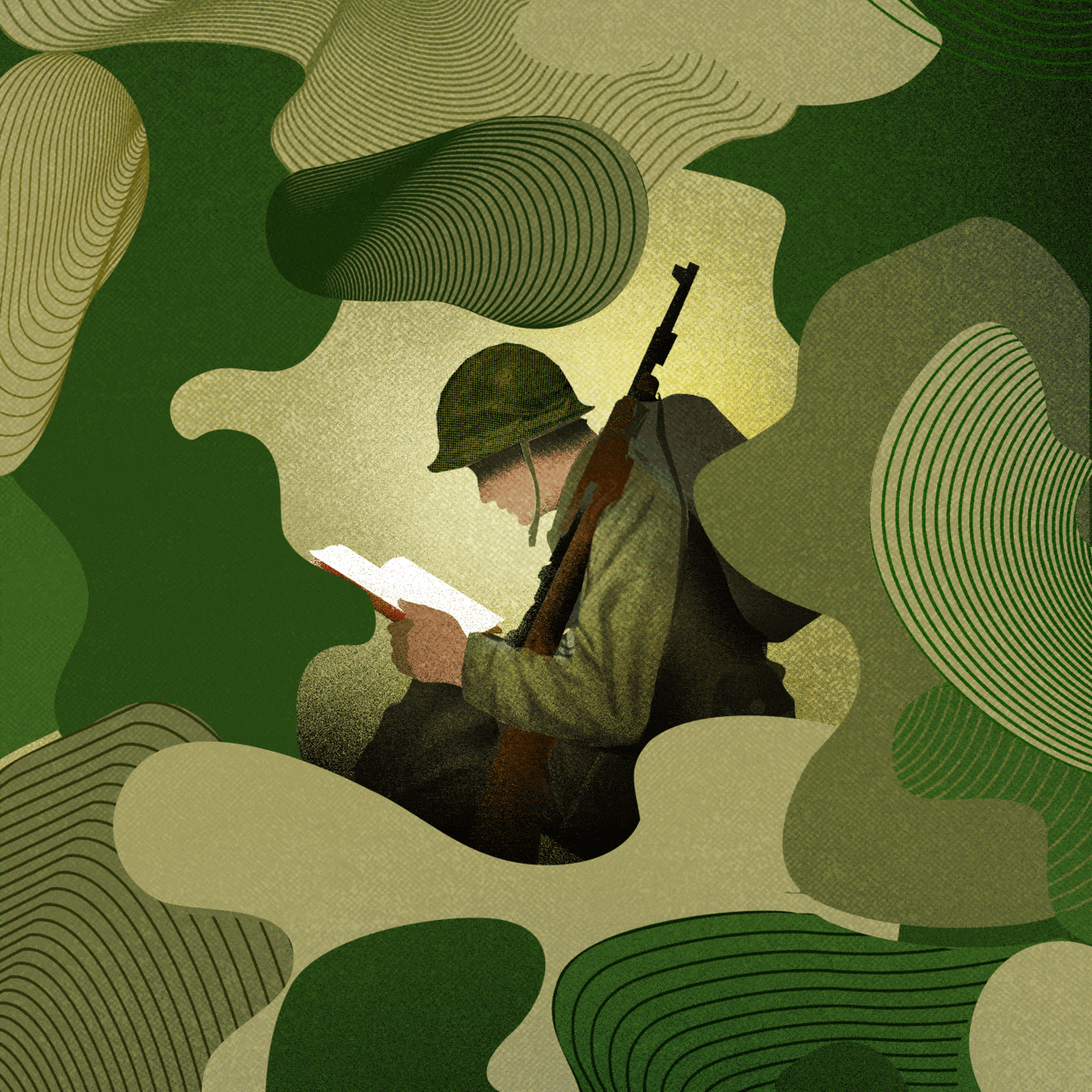Why Reader’s Digest Has Resonated with Military Families for 100 Years

From World War II to Afghanistan, America’s fighting men and women were always accompanied by a familiar friend.
In honor of the 100th anniversary of Reader’s Digest, we are looking back at some of our best moments from the past ten decades. Head here for more on our milestone anniversary.
After Warren Wiedhahn works through his Reader’s Digest, cover to cover, with a Marine’s precision, he passes it along to the employees at his travel company, which gives tours of military sites around the world. Now 92 years old, Wiedhahn first flipped through the magazine in the 1930s in his family’s outdoor privy in upstate New York. And he’s been passing his copies of the magazine around to others since he fought in the Korean War—when the ground was too frozen to dig foxholes but the mail still arrived, an always-welcome morale boost.
He shared his magazine again in the steamy jungles of Vietnam, where he was awarded the Silver Star for rallying his men to drive back the North Vietnamese troops who had surrounded them. The mail was delivered to even the most far-flung outposts, and if the choppers couldn’t land, crewmen dropped the mailbags out the open doors.
“Throughout it all,” says Wiedhahn, who lives just outside of Washington, D.C., “I had my Reader’s Digest in my pocket.”
RELATED: 22 Words and Phrases You Had No Clue Originated in the Military
Founded during war
That service members should connect with the magazine is fitting: The idea for Reader’s Digest was fine-tuned in war. The founder, DeWitt Wallace, had joined the Army in 1917. A year later, he was severely wounded during the massive Meuse-Argonne offensive. As he lay in a French hospital for four months recuperating from shrapnel wounds to his neck, back, and shoulder, he read American magazines and practiced trimming down the articles.
After the war, Wallace honed his idea for a magazine filled with articles condensed from other publications—one that would blend human interest, advice, and humor and tackle problems of the day. He couldn’t find a publisher to take a chance on him, so he and his wife, Lila Acheson Wallace, published it themselves.
Since the magazine’s debut in 1922, Wallace always made space for pieces about the military. In 1959, the magazine devoted nearly 60 pages across two issues to America’s most storied day of battle with a condensed version of Cornelius Ryan’s book The Longest Day, a sprawling retelling of D-Day based on 700 interviews with Allies and Germans. The story takes readers into transport planes as paratroopers tumble out, into German command posts wrought with confusion and disbelief, and, finally, onto those bloody beaches. “I’ll be all right, won’t I?” a mangled soldier asks Alfred Eigenberg, a 19-year-old medic faced with so many wounded that he doesn’t know where to start. “Sure,” says Eigenberg, and sticks the dying man with morphine. “You’ll be all right.”
The magazine followed up in 1974 with more stories from D-Day, including a letter from a woman whose father had been killed on Omaha Beach. “I never knew my father,” she wrote. “For years I hated him because I was tired of Mother talking about what the war was like and what a big hero my father was.” But her feelings changed after reading “The Longest Day” in the magazine. “My father became real to me. I cried because I love him, and he might have loved me. I cried, too, because his life was over before mine ever really began, yet he gave me my life. Thank you for giving me my father after all these years.”
Stories told without an agenda
Such sentiments help explain why the magazine has resonated for so long among military families. It gives those at home a glimpse of what their loved ones are doing, while connecting service members to the world they’d left behind, and to which, if their luck held, they’d be returning.
I started writing for the magazine a few years after I got out of the Army in 2005, after my own time overseas, and each story felt like an opportunity to introduce readers to their neighbors, to men and women not so different from the veterans they might have in their own families. I wrote about military chaplains ministering to troops on the battlefield, and dads tending the home front while moms were away at war. I wrote about a stealth fighter pilot and his unlikely friendship with the Serbian man who shot down his plane over the Balkans. After my former squad leader was killed in Afghanistan, I visited his platoon and wrote about the men he’d left behind, and their devotion to each other.
A magazine’s stories often carry subtle (and not so subtle) undertones of how readers are supposed to feel about a topic. While Reader’s Digest had plenty of that through its early years (articles railing against Communism, cigarettes, and marijuana, for example), its coverage of service members feels different to me—stories told without agenda, presented without pageantry. It was the magazine for the grunt, not the general. And the magazine has long celebrated an aspect of military life perhaps least understood by civilians and overlooked by other publications: the day-to-day absurdities of military life.
Over the decades, since the September 1953 issue, hundreds of thousands of service members and veterans have submitted stories to “Humor in Uniform” about the peculiarities, frustrations, and inside jokes of military life. Like the one about a soldier who turned 21 on the front lines of the Vietnam War. Amazingly, a birthday cake from his sister found him in his jungle outpost, miles from the nearest base. The cake was encased in Tupperware and came with this note: “Dick, when you’re finished, can you mail back my container?”
Warren Wiedhahn, the former Marine, learned to appreciate the absurd while trying to survive one of the fiercest battles of the Korean War. On November 27, 1950, Wiedhahn and a buddy spent the night at a listening post on a mountain ridge, out beyond their front lines. With dawn breaking, they heard a cacophony of whistles, bells, and bugles rising up from the other side of the valley. “What the hell is that?” Wiedhahn asked, and they soon saw thousands of Chinese soldiers flooding down the mountainside, heading straight for them. They quickly returned to their unit.
More than 120,000 enemy troops surrounded 30,000 American and allied troops, as temperatures plunged to 35 degrees below zero, in what became known as the Battle of Chosin Reservoir. The Marines couldn’t evacuate their casualties, and doctors wrestled with who could be saved. Those too badly wounded were placed outside the tent, deemed a more humane death, to sleep and not wake up. Two weeks later, after suffering more than 17,000 injuries and deaths, the American and allied troops broke through the enemy lines and withdrew.
Through it all, the magazine was a constant companion, nestled in the front pocket of Wiedhahn’s heavy, hooded parka. He passed it around, with 15 or 20 men reading each copy his parents sent. The jokes and funny anecdotes were always a favorite. “Humor in war kept us more natural, more human,” he says. “Even in the darkest days of combat, there was always somebody playing a trick, doing something stupid, or telling a joke. There you were getting shot at, and somebody told you a joke or you read something funny.”
RELATED: 31 Famous People You Didn’t Know Were Veterans
A trusted source in a complicated world
The magazine, of course, was more than a reliable source of diversion. Its hard-hitting articles and essays were to be trusted. If it was in Reader’s Digest, it had to be true.
George Burke was serving in the Army Air Force as a navigator on a B-24 Liberator bomber during World War II when his plane was shot down on a mission over northern France four days before D-Day. His captors marched him to a prisoner-of-war camp in Germany, where he was held until the war ended nearly a year later.
“He didn’t talk about it,” says his wife, Shirley Garrett, who is now 97 and lives in Clearwater, Florida. But she saw the effect the war had on him in the way his mood would drop so low, so fast. On weekends he would often retreat to his in-laws’ attic and thumb through the neat stacks of old Reader’s Digest magazines, which offered him respite.
“He could just slip away, read, and not be bothered by anybody,” Garrett says. But those back issues offered more than refuge in prewar America. They offered insight into how and why Burke ended up dropping bombs on occupied France. In 1930, he read the article “Adolf Hitler, German Hypnotist,”about the rise of the Nazis; in 1934, “Making Germany Gas-Proof,”about German cities preparing for war; and in 1935, “Where Does Hitler Get the Money?”about Germany’s massive efforts to rearm. “I just don’t understand how the U.S. didn’t see this coming,” he told Garrett. “It’s all right here.”
Perhaps the most endearing and enduring quality of Reader’s Digest has been the role it’s played in both war and peacetime, as the magazine that best exemplifies home for generations of readers and a reminder of the familiar, the comforting, and the cherished. It was stories about life on the farm, relatable personal dramas, profiles of fascinating people. As Warren Weidhahn says, Reader’s Digest, like no other magazine, “linked a lonely American Marine in a foreign country to home.”
It’s a sentiment that Beverly Dotson, of Charleston, Arkansas, still subscribes to. In the early 1990s, when her nephew Carl shipped off for months at sea aboard an aircraft carrier, Dotson figured he could use a dose of the home front, not to mention some humor to lighten his load.
For two years, from the Pacific to the Persian Gulf, Carl got a monthly rehash of the latest family happenings, along with clippings from Reader’s Digest.
“I think it’s important,” Dotson says, “when someone is out there, separated from their family, that they know they’re not forgotten.” And Reader’s Digest, she says, with its “funny, helpful, and inspiring articles, understands where we’re coming from.”
Dotson kept up the morale-boosting while her son and three nephews served in the Iraq War. And it continues today: She just sent another nephew, who serves in the Arkansas National Guard, a gift subscription.
Next, read up on the inspiring stories of how Reader’s Digest saved the life of these readers.
Brian Mockenhaupt served as an infantryman with the 10th Mountain Division from 2002 to 2005 and was deployed twice to Iraq. He has written about the military for the Atlantic, Smithsonian, Outside, and Esquire.



